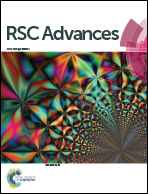Mild, green copper/4-dimethylaminopyridine catalysed aerobic oxidation of alcohols mediated by nitroxyl radicals in water†
Abstract
A novel copper/4-dimethylaminopyridine catalyst system has been found to catalyse the aerobic oxidation of a variety of primary and secondary alcohols in water at room temperature, in the presence of a TEMPO or ABNO nitroxyl radical. A tetranuclear CuII cluster was revealed to be a plausible reactive intermediate.


 Please wait while we load your content...
Please wait while we load your content...